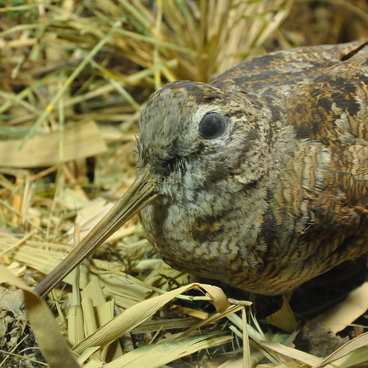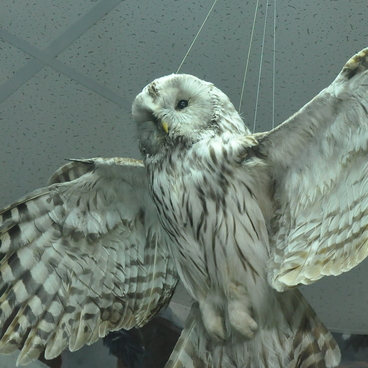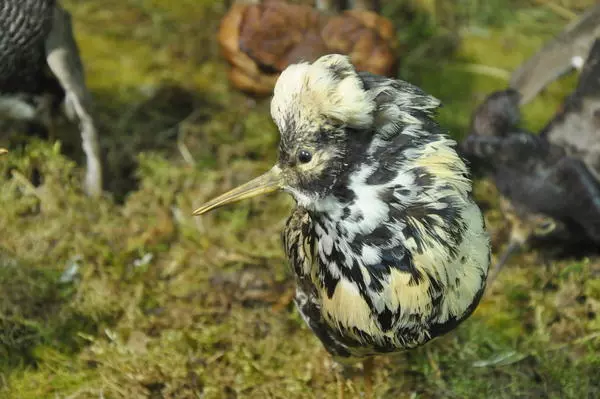The great eagle owl belongs to the order of Strigiformes. The bird’s Latin name is Bubo bubo. This is one of the biggest owls in the Transurals fauna. It has a barrel-shaped build, a loose plumage with mostly orange and ochroid shades, bright orange eyes and ear tufts of elongated feathers. The eagle owl normally doesn’t avoid humans and sometimes settles in towns, usually in Western Europe.
The eagle owl is a sedentary bird. It starts nesting once a year, in winter or early spring when the ground is still covered with snow. The eagle owl’s nest is a hole on the earth, without any lining. The birds willingly use all kinds of niches and shelves in coastal cliffs. Eagle owl pairs are for life, they often maintain their nesting place for many years.
The eagle owl is a nocturnal predator, though it can hunt for food in daytime on a winter or dull day. Having noticed a potential prey, the owl stoops down and sticks its claws in it. The eagle owl’s prey includes a large variety of animals, such as field and wood mice, ground squirrels and other rodents, hares, hazel hens and partridges, woodgrouse, capercaillies, and even hedgehogs. They can also consume frogs, fish, and sometimes descend to insects.
The eagle owl has a powerful voice and a rich sound repertoire. Its presence at a short distance is often disclosed by low two-syllable whooping which can be heard at up to 2-4 km distance in calm weather. In most instances, the whooping is associated with male calls, though females, too, are capable of similar sounds, only lower pitch. Sometimes one can hear a dialogue of both birds, often growing into endless roaring. A disturbed eagle owl signal is fast, active, and laughter-like. Among the distinguished sounds, there are ‘crying’, humming, and depressive calls.
In zoos, eagle owls live up to 70-80 years, in their natural habitat much less (there has been one recorded instance of an eagle owl living more than 21 years). Over the 20th century, human activities resulted in an unrestrained decrease in their population. The species is now included in the Russian and Kurgan Oblast Red Book of Endangered Species.
The eagle owl is a sedentary bird. It starts nesting once a year, in winter or early spring when the ground is still covered with snow. The eagle owl’s nest is a hole on the earth, without any lining. The birds willingly use all kinds of niches and shelves in coastal cliffs. Eagle owl pairs are for life, they often maintain their nesting place for many years.
The eagle owl is a nocturnal predator, though it can hunt for food in daytime on a winter or dull day. Having noticed a potential prey, the owl stoops down and sticks its claws in it. The eagle owl’s prey includes a large variety of animals, such as field and wood mice, ground squirrels and other rodents, hares, hazel hens and partridges, woodgrouse, capercaillies, and even hedgehogs. They can also consume frogs, fish, and sometimes descend to insects.
The eagle owl has a powerful voice and a rich sound repertoire. Its presence at a short distance is often disclosed by low two-syllable whooping which can be heard at up to 2-4 km distance in calm weather. In most instances, the whooping is associated with male calls, though females, too, are capable of similar sounds, only lower pitch. Sometimes one can hear a dialogue of both birds, often growing into endless roaring. A disturbed eagle owl signal is fast, active, and laughter-like. Among the distinguished sounds, there are ‘crying’, humming, and depressive calls.
In zoos, eagle owls live up to 70-80 years, in their natural habitat much less (there has been one recorded instance of an eagle owl living more than 21 years). Over the 20th century, human activities resulted in an unrestrained decrease in their population. The species is now included in the Russian and Kurgan Oblast Red Book of Endangered Species.


